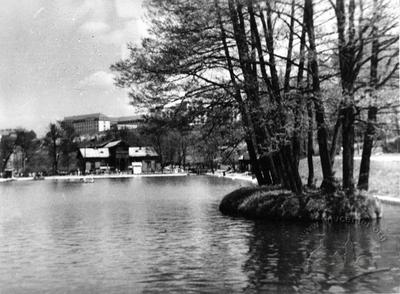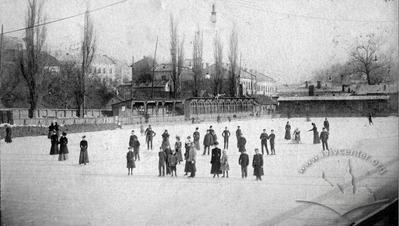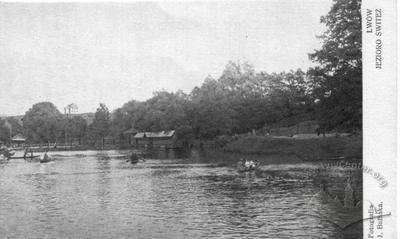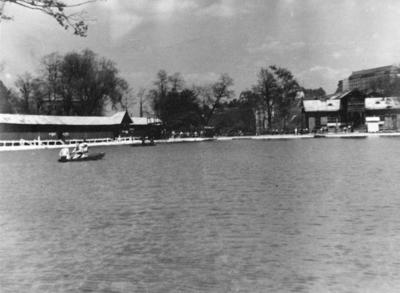Vul. Horbachevskoho, 24 – "Medyk" sport complex
The complex covers an area bounded on the east where Sakharov Street joins Princess Olha Street; on the west by structures along Morshynska and Pryrodna Streets; on the south by a section of land belonging to the The National Forestry and Wood-Technology University of Ukraine; and by Horbachevskyi Street on the north. The main entrance faces Horbachevskyi Street, with a service entrance from the Morshynska side. The complex has two swimming pools, tennis courts, a green for “horodky” (a national game similar to lawn bowling), play areas, and a multi-purpose sport area.
The territory has been a favorite of swimmers since the beginning of the 19th century, and was named Svytiaz toward the end of the century. The facility was held in private hands until 1939; after 1945 it was transferred to the Lviv Medical Institute where its current designation - Medic - hails from. During the 1970s, the complex belonged to the Avantgarde sports club. It is currently, once again, privately-owned. A major reconstruction, designed by Yaroslav Novakivskyi, was undertaken in 1955, with renovations following in the 1990s and early 2000s.
Architecture
The complex has managed to maintain its original purpose through the years, and currently offers activities across the territory of the park. The uppermost area was designated for handball and track and field. In the 1990s, the handball courts were refitted for archery, and since October 2011 the space has been used for paintball competitions. The lowermost area holds the swimming pools, tennis courts, and lawn-bowling pitch.
The complex has three swimming pools. The large pool, running north to south, was employed for swimming and rowing races in the summer, and for ice skating in the winter. The smaller pool was set east-west, and was the deepest of the three, used for swimming, diving, and water polo. Another pool, built apart from the others, and designed for swimming and hockey, once sat on the complex’s north side. In contrast to the other pools, it was constructed asymmetrically. It no longer exists; its place occupied by the Dacha restaurant.
Since the mid-2000s, the large swimming pool has been used as an ice rink during the winter months. There have been noises about the building of a modern sports arena, but nothing has come of it. A small island at the southern end of the pool provides an interesting compositional element to the facility. Pleasantly landscaped with a footbridge from the bank, the island holds an entertainment hall which has stopped operating only recently.
The northernmost area of the complex, with its tennis courts, bleachers, and lawn-bowling area, is surrounded by large, chain-link fence.
Located midway between the tennis courts and the main path there is now a rope & climbing adventure area. An area for bowling originally occupied the terraces, dug out from the hillocks near Morshynska Street. Over the years the area was converted to basketball and volleyball courts.
Administrative and service buildings occupy n the eastern section of the campus, near Princess Olga Street. The main entrance, with its six-columned porch, reflects the architectural tendencies of the 1950s (Yaroslav Novakivskyi, 1955). A metal gate stands at the Morshynska side entrance. The entire territory is enclosed by a fence.
Personalities
Wojciech Fochsa, Jan Turnik, Piotr Feit, Jan Boznański, Wincenty Gorecki, Bodaszewski, Leopold Fechter, Franciszek Zygmunt Leski, Oleksandr Pezhanskyi, Ludwik Sawka, Leon Legeżyński, Jan Winiarz, Władysław Śmiałowski, Edward Mustapowicz: the architects and buildings of Svytiaz.
Emilia Marion. From 1891, the owner of the swimming area, who named it Svytiaz.
Yaroslav Novakivskyi. Architect and designer of the 1955 complex reconstruction.
Stanisław Dutko. Swimming competition organizer at Svytiaz, 1906.
Władysław Marion. Oarsman from the winning Seagulls rowing team, 1908.
Tadeusz Kuchar. Competitive swimmer. 100m Free-style champion from the 1908 Svytiaz competition.
Roman Shukhevych. Backstroke champion from the 1923 IV Zaporizhia Games, and the future General “Chuprynka” of the Ukrainian Insurgent Army.
Volodymyr Shulhin. 1961 USSR Handball champion.
Sources
Lviv Oblast State Archive (DALO), 2/1/5922:143
Orłowicz, Mieczysław. Moje Wspomnienia.Warszawa, 1975. 454
Trofimyak, B. Physical Education and the Sports Movement in Western Ukraine (1930-1939). Kyiv: IZYN, 1997. 174
Vatseva, Oksana. Abstracts from the History of Sport in Western Ukraine. Ivano-Frankisvsk: Lilea-NV, 1997. 91-92
Book of Commemoration of the 35th Anniversary of the Chase Lviv Sports Club. Lviv, 1935). 35, 171, 179.
(Księgapamiątkowa ku czci 35-lecia Lwowskiego Klubu Sportowego “Pogoń”. Lwów, 1935).
Media Archive Materials
Related Pictures














